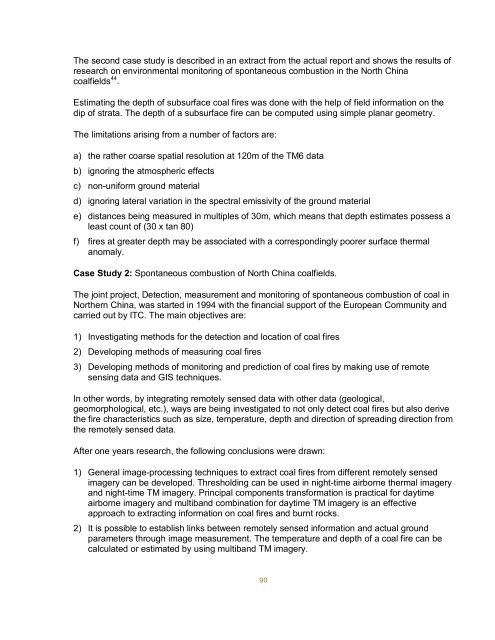prevention and control of spontaneous combustion - Mining and
prevention and control of spontaneous combustion - Mining and
prevention and control of spontaneous combustion - Mining and
Create successful ePaper yourself
Turn your PDF publications into a flip-book with our unique Google optimized e-Paper software.
The second case study is described in an extract from the actual report <strong>and</strong> shows the results <strong>of</strong><br />
research on environmental monitoring <strong>of</strong> <strong>spontaneous</strong> <strong>combustion</strong> in the North China<br />
coalfields 44 .<br />
Estimating the depth <strong>of</strong> subsurface coal fires was done with the help <strong>of</strong> field information on the<br />
dip <strong>of</strong> strata. The depth <strong>of</strong> a subsurface fire can be computed using simple planar geometry.<br />
The limitations arising from a number <strong>of</strong> factors are:<br />
a) the rather coarse spatial resolution at 120m <strong>of</strong> the TM6 data<br />
b) ignoring the atmospheric effects<br />
c) non-uniform ground material<br />
d) ignoring lateral variation in the spectral emissivity <strong>of</strong> the ground material<br />
e) distances being measured in multiples <strong>of</strong> 30m, which means that depth estimates possess a<br />
least count <strong>of</strong> (30 x tan 80)<br />
f) fires at greater depth may be associated with a correspondingly poorer surface thermal<br />
anomaly.<br />
Case Study 2: Spontaneous <strong>combustion</strong> <strong>of</strong> North China coalfields.<br />
The joint project, Detection, measurement <strong>and</strong> monitoring <strong>of</strong> <strong>spontaneous</strong> <strong>combustion</strong> <strong>of</strong> coal in<br />
Northern China, was started in 1994 with the financial support <strong>of</strong> the European Community <strong>and</strong><br />
carried out by ITC. The main objectives are:<br />
1) Investigating methods for the detection <strong>and</strong> location <strong>of</strong> coal fires<br />
2) Developing methods <strong>of</strong> measuring coal fires<br />
3) Developing methods <strong>of</strong> monitoring <strong>and</strong> prediction <strong>of</strong> coal fires by making use <strong>of</strong> remote<br />
sensing data <strong>and</strong> GIS techniques.<br />
In other words, by integrating remotely sensed data with other data (geological,<br />
geomorphological, etc.), ways are being investigated to not only detect coal fires but also derive<br />
the fire characteristics such as size, temperature, depth <strong>and</strong> direction <strong>of</strong> spreading direction from<br />
the remotely sensed data.<br />
After one years research, the following conclusions were drawn:<br />
1) General image-processing techniques to extract coal fires from different remotely sensed<br />
imagery can be developed. Thresholding can be used in night-time airborne thermal imagery<br />
<strong>and</strong> night-time TM imagery. Principal components transformation is practical for daytime<br />
airborne imagery <strong>and</strong> multib<strong>and</strong> combination for daytime TM imagery is an effective<br />
approach to extracting information on coal fires <strong>and</strong> burnt rocks.<br />
2) It is possible to establish links between remotely sensed information <strong>and</strong> actual ground<br />
parameters through image measurement. The temperature <strong>and</strong> depth <strong>of</strong> a coal fire can be<br />
calculated or estimated by using multib<strong>and</strong> TM imagery.<br />
90

















